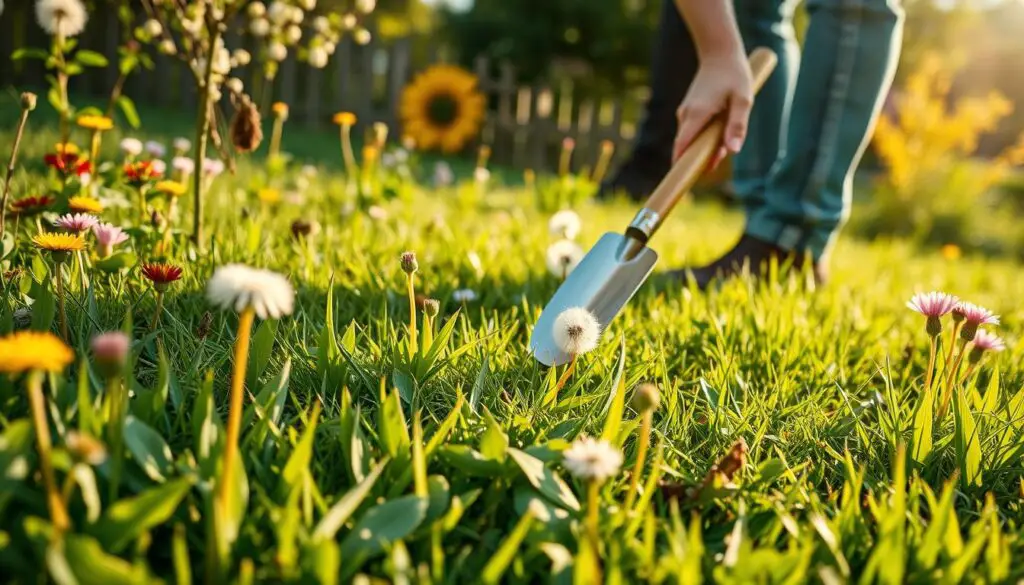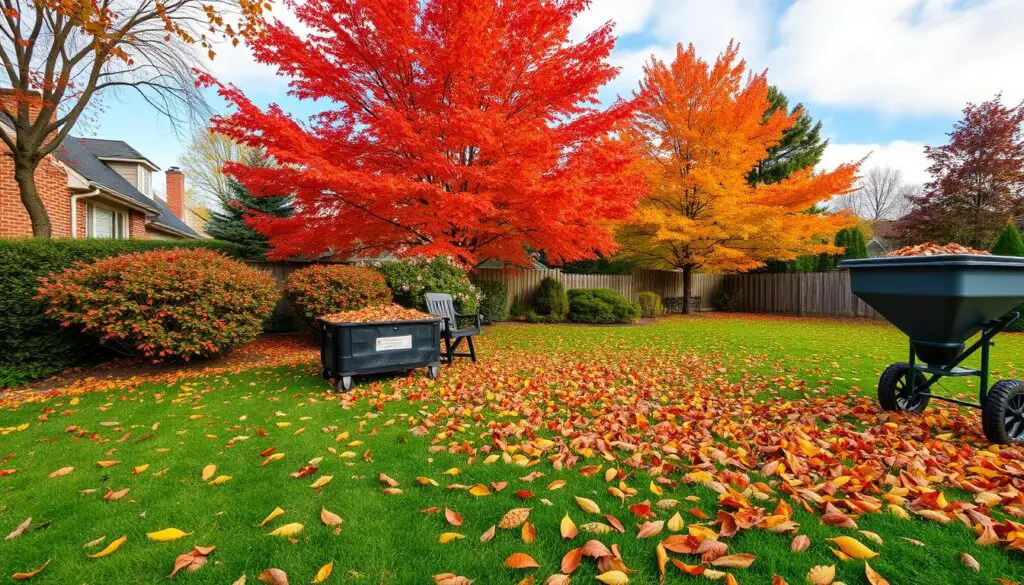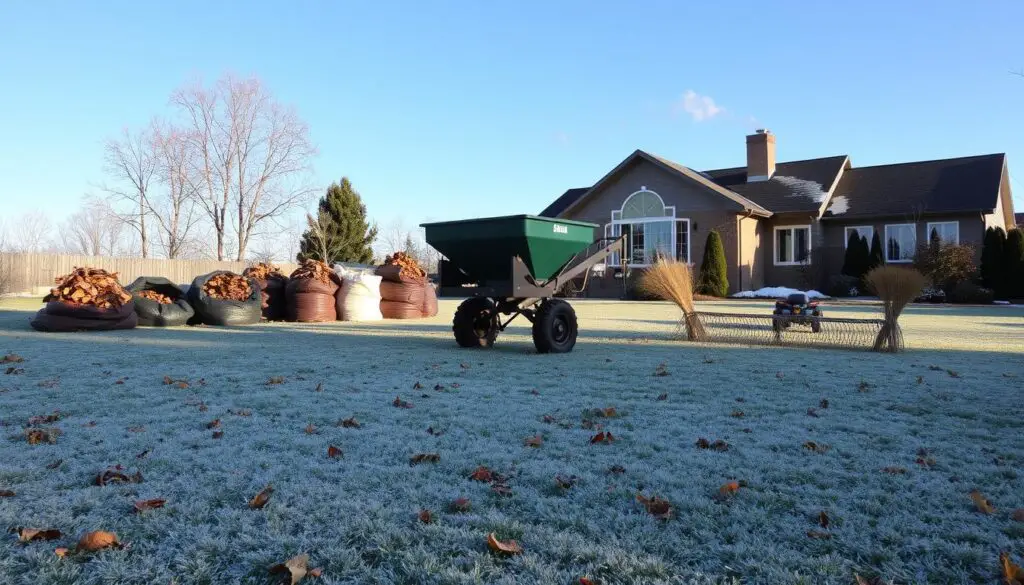Best Practices for Lawn Care Throughout the Seasons

Did you know a well-kept lawn can boost your home’s value by up to 15%? That’s a big gain for just a few seasonal tasks. As a homeowner, I’ve found that making your lawn look great isn’t hard. The key is to do the right things at the right time.
This guide will show you how to make your lawn the best on the block. You’ll learn how to care for your lawn all year round.
Key Takeaways
- Develop a lawn care schedule tailored to your regional climate and grass type
- Utilize the right lawn care products and equipment for each season
- Prioritize weed control, bare spot repair, and overseeding for a thick, healthy lawn
- Maintain proper mowing height and watering practices to support grass growth
- Fertilize at the optimal times to nourish and strengthen the lawn
Spring Lawn Care Essentials
Spring is here, and it’s time to make your lawn look great. You’ll need to clean up, mow, and fertilize the grass. This will help your lawn grow strong and healthy all year.
Clean Up Dead Grass and Debris
Start by removing dead grass, leaves, and debris from winter. This lets your lawn breathe and grow. Make sure to clean areas damaged by snow mold or winter weather well.
Adjust Mower Height and Mow High
When you start mowing, set your mower to the highest height. Cutting the grass long helps it grow deeper roots. This also keeps weeds from growing. Keep your lawn high throughout spring and summer for a lush look.
Apply Fertilizer to Nourish and Strengthen
- Use a balanced spring fertilizer to help your lawn grow and recover.
- The best time to fertilize is three weeks after your grass starts growing, or after your first few mows.
- Good fertilizing makes your grass stronger, denser, and better at fighting weeds.
By doing these spring lawn care tasks, you’ll have a strong, weed-free lawn. A little work now means a beautiful outdoor space all year.
Controlling Weeds in Spring
As the days get longer and the grass turns green, it’s time to fight spring weeds. Weeds like dandelions and wild violets can quickly spread if not stopped. But, with the right steps, you can keep your lawn weed-free and vibrant.
Spot Treat Dandelions and Wild Violets
When weeds first appear, it’s crucial to act fast. Use spot treatment with a selective herbicide to target weeds without harming your grass. This method is perfect for tackling dandelions and wild violets.
Also, keep an eye on your lawn. Regularly walking it and pulling out small weeds can stop them from spreading. This, along with spot treatment, is a strong defense against spring weeds.
“The best time to apply pre-emergent herbicides is in early spring, before any weeds have a chance to germinate and take root.”
Pre-emergent herbicides are also vital for spring weed control. They create a barrier that stops weed seeds from sprouting. Apply these early to prevent weeds from growing.

By using spot treatment for existing weeds and pre-emergent herbicides early, you can keep your lawn weed-free. With some effort and the right tools, you can enjoy a beautiful outdoor space all season.
Repairing Bare Spots and Overseeding
Keeping your lawn green and lush requires ongoing effort. One common issue is dealing with bare spots or thin areas. Fortunately, you can fix these spots by overseeding. This method works for all types of grass, whether cool-season or warm-season.
For cool-season grasses, overseed in early spring. This is when the soil is perfect for seed germination. Warm-season lawns do best with overseeding in late spring to early summer. It’s important to prepare the soil well, choose the right seed, and ensure good seed contact.
To start, find and fix the bare spot’s. This might mean improving soil drainage or fixing compaction. Once the soil is ready, spread the seed at the right rate and rake it in gently.
Keep the seeded area moist with light watering until the grass grows. This usually takes 10 to 14 days. Once the grass is tall enough, include it in your regular lawn care. This means mowing, fertilizing, and controlling weeds and pests.
With the right steps, you can turn bare spots into a lush, green lawn. By overseeding at the best time and following the right soil and seed care, your lawn will be beautiful for years.
Summer Lawn Maintenance
When it gets hotter and sunnier, taking care of your lawn is key. By doing a few important things, you can keep your grass looking great. This helps avoid problems like grubs and pests damaging your lawn.
Mow at Proper Height for Grass Type
It’s important to mow your lawn at the right height for your grass type in summer. Warm-season grasses like Bermuda and Zoysia need to be cut between 2-3 inches. Cool-season grasses, such as Tall Fescue and Kentucky Bluegrass, do best when mowed between 3-4 inches. Sharp mower blades help prevent moisture loss and encourage deep root growth.
Treat for Grubs and Pests
Summer brings pests like Japanese beetles, June bugs, and European chafers. These grubs can harm your grass by eating the roots. Use a product like Scotts® GrubEx® Season Long Grub Killer to stop infestations. Also, watch out for ants, ticks, and chinch bugs and treat them quickly.

By following these tips, you can have a lush, green lawn all summer. Remember to mow right, treat for pests, and keep an eye on your lawn. With some care, your lawn will be a beautiful spot to enjoy all season.
Watering and Irrigation Tips
To keep your lawn lush and healthy, watering is key. Remember, “An inch of water per week, either from rain or irrigation, is the key to a thriving lawn.” Watering in the early morning, between 5 a.m. and 10 a.m., is best. It helps water soak in better and reduces evaporation.
Thinking about improving your outdoor space? An underground sprinkler system can save you time and ensure your lawn gets water evenly. These systems adjust to the seasons, so you can change your watering schedule as needed.
Looking for a budget-friendly option? Installing shut-off devices for rain detection can save water and prevent overwatering. Or, consider low-volume drip irrigation systems. They’re efficient and cut down on water waste.
It’s important to check and maintain your watering system regularly. This ensures it works right and waters your lawn just enough. Too much water can harm your lawn as much as too little.
Timing is crucial when watering your lawn. Watering in the early morning means less water lost to evaporation. Also, watering deeply but less often encourages strong root growth. This makes your lawn more durable.
Cool-season grasses like Kentucky bluegrass might need less water in summer and more in fall. Warm-season grasses, on the other hand, thrive in heat and need less water. By following these lawn watering and irrigation systems tips, your lawn will stay healthy all year. You might even increase your home’s value by up to 14 percent.
Fertilizing for Summer Growth
As summer arrives, your lawn needs the right nutrients to grow well. Summer lawn fertilization is vital for warm-season grasses and keeps cool-season grasses healthy in the heat.
Use a fertilizer made for summer. It should also protect your lawn from insects. Look for slow-release nitrogen, like Milorganite, at 10 lbs per 1,000 square feet. This feeds your grass without overloading it.
For more nourishment, try the “Double Dark” mix. Mix 9 oz per 1,000 sq ft of MicroGreene with 26 oz per 1,000 sq ft of Greene Effect every 6-7 weeks. This combo replenishes nutrients lost in extreme weather, keeping your lawn green and lively.
| Fertilizing Schedule | Recommended Timeframe |
|---|---|
| Early Spring Lawn Fertilizer | February to April |
| Late Spring Lawn Fertilizer | April to June |
| Summer Lawn Fertilizer | June to August |
| Fall Lawn Fertilizer | August to November |
By sticking to a summer lawn fertilization plan, your lawn will stay lush and strong. A bit of extra care now will reward you with a stunning landscape all summer.
“Fertilizing your lawn once a year can improve its condition, but feeding it 4 times a year can make it even healthier and more beautiful.”
Fall Lawn Care Routine
As the seasons change, it’s important to focus on fall lawn care. This ensures our lawns are ready for the cold months. One key task is fertilizing for root growth and strength.
Using a balanced fertilizer like Scotts® Turf Builder® WinterGuard® Fall Weed & Feed3 or Scotts® Turf Builder® WinterGuard® Fall Lawn Food is crucial. It gives your lawn the nutrients it needs to stay healthy through winter. This also helps it look great in the spring.
Fertilize for Root Growth and Strength
Experts say to fertilize your lawn twice in the fall. This helps rebuild the grassroots damaged in summer. It strengthens your lawn and prepares it for winter.
By properly [fertilizing] your lawn in the fall, it stays healthy and lush. This is key for a strong next growing season.
Overseed Thin or Bare Areas
Overseeding thin or bare spots is also vital in the fall. It thickens your lawn and makes it weed-resistant before winter. Overseeding takes seven to 21 days to germinate, so plan ahead.
By following these fall lawn care steps, your lawn can recover from summer stress. It sets it up for success next year. Tailor your lawn care to your climate and lawn type for the best results.
“Develop a comprehensive fall lawn care schedule, including tasks like aerating, overseeding, and applying fall fertilizer.”

Don’t forget other important fall lawn care tasks. These include mulching leaves, mowing the lawn shorter, and ensuring proper watering until the ground freezes. A proactive approach to fall lawn care leads to a healthy, thriving lawn all year.
Preparing Lawn for Winter
Winter is coming, and it’s time to get our lawns ready. Winterizing your lawn keeps it healthy and green when spring arrives. Let’s look at the essential steps to take before the first frost.
Mulch Leaves into Lawn
Mulching leaves into your lawn is a key fall task. Use your lawnmower to chop up leaves and let them break down on the lawn. This leaf mulch adds organic matter that feeds the soil all winter. It helps your lawn look vibrant next year.
Final Low Mow Before Winter
For your last cut, set the mower to 1-1.5 inches. Cutting the grass shorter helps it get ready for winter. It also prevents matted grass that can cause disease. Don’t cut too much at once to avoid stressing the lawn.
By mulching leaves and doing a final low mow, you’ll have a lawn winterized and ready for spring. Preparing your lawn now will make a big difference later.

Seasonal lawn care
Keeping a lawn healthy and lush needs the right care at the right time. By following a seasonal lawn care routine, I can make sure my grass looks great all year. This includes mowing, fertilizing, overseeding, and pest control.
In spring, lawn care is key. I aerate the soil after a rain to help air, water, and nutrients reach the roots. I mow regularly, at least every two weeks, and increase to weekly as summer gets closer.
Summer means mowing weekly, keeping the grass between three to five inches. I watch for pests like grubs and deal with them quickly. When fall comes, I focus on dethatching, top-dressing with compost, and overseeding to get the lawn ready for winter.

